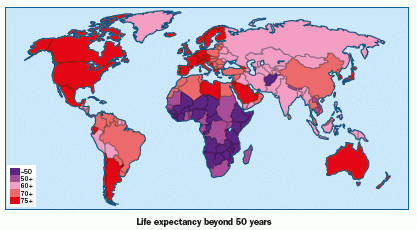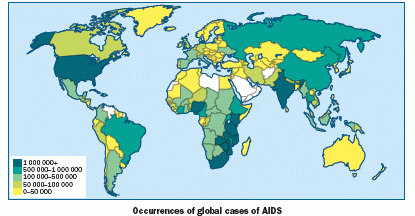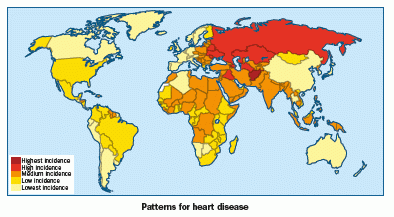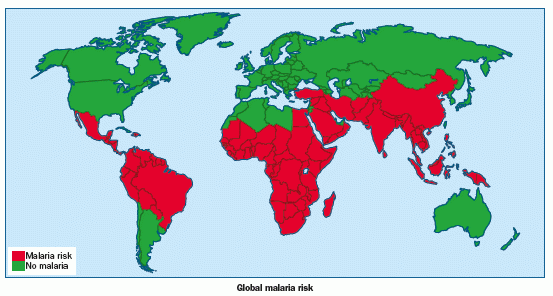Health and welfare
Global health and welfare
Health and welfare relates a population’s standard of living and quality of life to economic, social and environmental factors. Generally, better health equates to high levels of wealth.
Health equates to an absence of disease - One of the indicators of good health is longevity. The map above indicates those expected to live beyond 50 years of age. This demonstrates that those in living in LEDCs are least likely to reach this age.

Disease can determine morbidity - The pattern of global morbidity depends on the type of disease – it can be infectious (AIDS/malaria) or an ‘affluent’ disease, such as heart disease. The prevalence and incidence determines the number of cases at any one time. The map below demonstrates the occurrences of global cases of AIDS. It is obvious that this is a global disease (note also the concentrations of AIDS in LEDCs). Sub-Saharan Africa has faced the HIV/AIDS challenge for some years now.

Case study: AIDS in Sub-Saharan Africa
Sub-Saharan Africa is heavily affected by HIV and AIDS. An estimated 22.4 million people are living with HIV in the region – around two-thirds of the global total. In 2008 around 1.4 million people died from AIDS in Sub-Saharan Africa and 1.9 million people became infected with HIV. Since the beginning of the epidemic, more than 14 million children have lost one or both parents to HIV/AIDS.
In the absence of massively expanded prevention, treatment and care efforts, it is expected that the AIDS death toll in Sub-Saharan Africa will continue to rise. The social and economic consequences of AIDS are widely felt, not only in the health sector, but also in education, industry, agriculture, transport, human resources and the economy in general.
Sub-Saharan Africa faces a triple challenge.
- Providing health care, anti-retroviral treatment, and support to a growing population of people with HIV.
- Reducing the annual toll of new HIV infections by enabling individuals to protect themselves and others.
- Coping with the impact of over 20 million AIDS deaths, on orphans and other survivors, communities and national development.
Diseases of affluence
The map (below) shows morbidity patterns for heart disease around the world. Affluent countries on the whole dominate this map, though as the populations of developing countries eat more processed food their totals are expected to climb rapidly. It is also worth comparing this map with longevity as heart disease is mostly a disease of old age, but also relates to poor health style.

Impact of disease
Generally high morbidity causes high mortality, but MEDCs have the resources to reduce the incidence of death, whereas LEDCs don’t. Examples of resources in MEDCs include:
- education and training
- medical advice and its availability
- better housing, sewage and cleaner water systems
- vaccination to protect against disease
- other measures to reduce disease, such as spraying mosquito infested areas
- improved nutrition for all.
Health in the UK
Some general points about the state of health of the population in the UK.
- Women live longer than men, but can die of chronic disease.
- With people living longer there is less tax base from the working population to support a stressed National Health Service (NHS).
- Income can affect health! Wealth = better health care = south-east UK is the healthiest region.
- There is a north vs. south divide in general healthiness in the UK.
Case study: Malaria
The malaria life cycle is as follows.
- Infected mosquito bites human.
- Parasite goes to the liver within 30 minutes.
- The parasite starts reproducing in the liver, some lie dormant in the liver, to reactivate and cause diseases often long after the initial infection.
- The parasite gets into the blood stream, attaches to and enters red blood cells.
- Infected red blood cells burst, infecting other blood cells.
- This repetitive cycle causes fever and depletes the body of oxygen-carrying red blood cells. Infected red blood cells clog up the circulation in vital organs such as the brain and kidney.
- As infection progresses, sexual forms of the parasite are released into the blood stream. When a mosquito bites, it takes up these parasites and the cycle of infection is perpetuated placing others at risk.
Every year 300–700 million people get malaria. It kills 1–2 million people every year. The biggest problem is in Africa where 90% of the people who contract malaria die. Most of the people who die from malaria are children. In Africa, 20% of children under five die from malaria. Most of these deaths could be stopped with medicine or with ways to stop mosquitoes. Many of the places malaria may be found are in poor countries. These countries do not have enough money to stop the mosquitoes or to give people medicine.
There are three ways to prevent malaria.
- Control mosquitoes using DDT or a similar chemical, though its use is now known to be dangerous!
- Stop mosquitoes from biting (use nets).
- Take medicine to prevent getting sick after a bite (anti-retroviral tablets before, during and after a trip to a known infected area).

